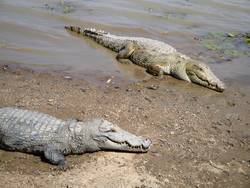Mare aux hippopotames

© J.N. Poda
Fisher boats in Mare aux hippopotames Biosphere Reserve
The Mare aux Hippopotames Biosphere Reserve is located about 60 km north of Bobo-Dioulasso in the Houet province of south-west Burkina Faso. It is known for its freshwater lake (‘mare’) with associated pools and marshes in the floodplain of the Volta Noire River, as well as for its gallery forests. The reserve contains a great variety of biodiversity, especially near the lake after which the reserve is named.
Designation date: 1986
Administrative authorities: Office National des Aires Protégées (OFINAP).
Surface area (terrestrial and marine): 19,200 ha
Core area(s): 6,518 ha
Buffer zone(s): 9,836 ha
Transition area(s): 2,846 ha
Location
Latitude: 11°29’6”N – 11°43’37”N
Longitude: 4°05’52”W – 4°12’03”W
Midpoint: 11°36’10”N – 4°09’28”W
Ecological Characteristics

© Thomas Schaaf
Crocodiles in the Mare aux Hippopotames Biosphere Reserve
The reserve has characterized by a Sudanese climate type with two distinct seasons – a dry season lasting eight months and a rainy season lasting four months. The reserve includes five types of vegetation: forests, wooded savannah, and vegetation found on the ferruginous crust and in aquatic and flood areas. The forest takes the form of corridors along the Mouhoun rivers (gallery forests) while a lake extends over 660 ha, serving as a principal attraction.
The flora includes 191 species with 136 genus and 52 families. Thirty-three species have been registered in the gallery forests and some about 20 for the flood and aquatic vegetation areas. The flora of the savannahs and open forests include about 100 species, while the vegetation on the ferruginous crust approaches 70 species and about 40 species for the fallow land areas.
Wild mammals include a population of hippopotamus (Hippopotamus amphibius) divided into three families, elephants (Loxodonta Africana), West African crocodiles (Crocodylus suchus), large antelopes such as the sable antelope (Hippotragus niger), and numerous primates such as the patas monkey (Erythrocebus patas) and warthogs (Phacochoerus africanus africanus). Birdlife is represented by 160 species of water fowl, mainly kingfishers, white-faced whistling duck (Dendrocygna viduata) and the golden breasted Jacana (Actophilornis africanus). The lake itself hosts 34 types of fish, represented mainly by tilapia (Oreochromis niloticus), catfish and African knifefish (Gymnarchus niloticus).
La Mare aux Hippopotames is also a Ramsar Wetlands Site.
Socio-Economic Characteristics

© Thomas Schaaf
Village in the Mare aux Hippopotames Biosphere Reserve
The Mare aux Hippopotames Biosphere Reserve is surrounded by 10 villages, which are home to approximately 40,000 inhabitants (2006). The Bobo are the main ethnic group in the area. Agricultural pressure around the reserve is strong (market crops and domestic plantations) and based around cotton and corn. Other principal economic activities include artisanal fishing on the lake and along the River Mouhoun, traditional animal husbandry with cattle, sheep and goats around the reserve, and traditional and modern bee-keeping inside and around the reserve.
> Back to Biosphere Reserves in Burkina Faso
Last updated: April 2018
Back to top

